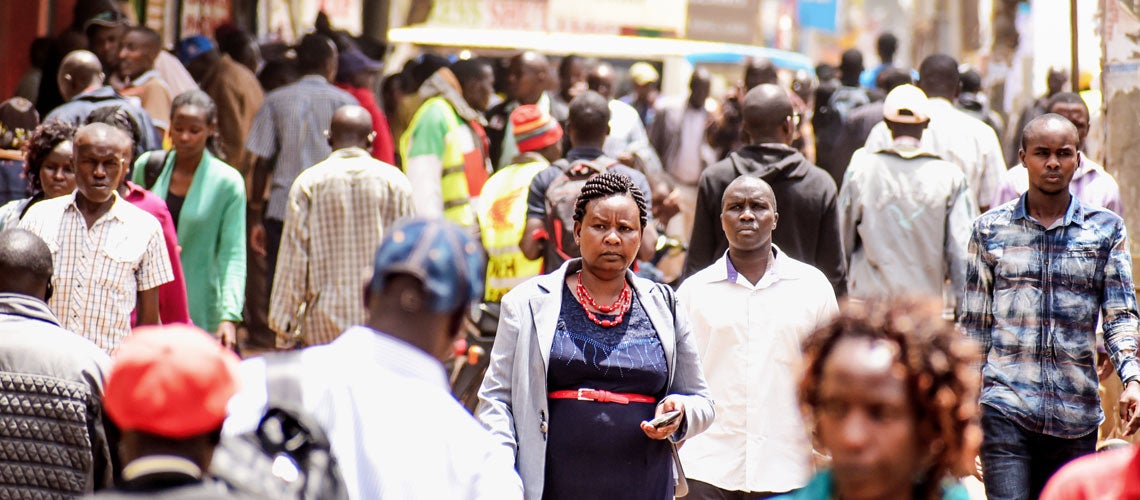 Downtown of Nairobi City, Kenya, East Africa
Downtown of Nairobi City, Kenya, East Africa
The October-December 2022 rainy season is still unfolding in Kenya and prices continue to rise. It would be important for policymakers to monitor how families adapt to high prices and uncertain rains. Here’s why.
In the first half of 2022, Kenyans experienced both sharp increases in the prices of food, fuel, and inputs and below average rainfall. Coming at the tail end of pandemic-related economic disruptions, these shocks took a toll on many. The World Bank conducted a Rapid Response Phone Survey (RRPS) in June 2022—its eighth in the past few years—to find out how families were affected.
Nearly everyone experienced either price or rainfall shocks
The RRPS asked families about the shocks they faced. Almost all were affected by higher prices for food and energy. Rural families also experienced other shocks that hurt their incomes: higher input prices (74%), variable rains or drought (60%), crop disease and pests (43%), and livestock deaths (16%). The higher prices of inputs and variable rain affected urban families too: 45% experienced higher input prices, 32% reported loss of earnings and 17% faced business closure. Overall, families involved in running businesses or farms were more commonly impacted by supply side than demand side shocks (less than 10% reported a fall in price of outputs).
Most families took some action in response, such as cutting food consumption or borrowing
When the RRPS interviewed families during the peak of the COVID-19 pandemic (May-June 2020, July-September 2020), 20% reported having taken no steps in response to the crisis. This share fell to only 5.6% in June 2022, indicating that more families had to find ways to make ends meet in June 2022 than during the pandemic. In one respect, the response of families during the recent price and weather crises was similar to that during the pandemic: close to 50% reported cutting back on food consumption and 35% cut back nonfood consumption.
However, in contrast to the pandemic crisis, in June 2022, the share of families seeking assistance from their own social networks or opting for credit rose sharply: 58% borrowed or sought help from their social networks and 34% purchased items on credit.
Most of the families surveyed received no assistance from the government or from non-governmental organizations in 2020 or during the recent price and weather shocks. Taken together, these findings raise concerns about the weakening capability of families to adjust their living standards or to self-insure as they deal with accumulating crises.
Food insecurity rose sharply as well
The share of families who had family members going hungry from lack of food in the past 30 days jumped from a third in November 2021–March 2022 to more than a half in June 2022, reverting to levels seen at the height of the pandemic. While the National Drought Management Authority (NDMA) documented rising food insecurity in Arid and Semi-Arid Lands (ASAL) counties of Kenya, RRPS data show that families in non-arid parts of the country also experienced a rise in food insecurity in June.
Some agricultural families could not translate the higher food prices into more earnings
For farming and livestock owning families, the combination of weather and input price shocks had a negative impact on harvests: 90% of respondents in drought-affected counties (as of June 2022) and 43% in non-drought affected counties reported lower harvests than in the previous season. A reduction in agricultural earnings compared to June 2021 was reported by 40% of the families, with average earnings 38% lower. The most frequently reported reasons for lower agricultural sales were drought and bad rains (63%) and the higher cost of supplies and materials (30%).
Agricultural families, especially those headed by women, responded to the shocks by adjusting consumption and investment
All else equal, women-headed agricultural families were 20% more likely than male-headed families to cut back on food consumption. Similarly, the presence of children in the family was associated with a higher probability of cutting back on the consumption of both food and non-food items.
Some respondents cut back on planting (and therefore protected themselves against risky and costly investments): 38% of agricultural families in ASAL counties and 30% in non-ASAL counties planted less than in the previous planting season, a sharp rise from 2021. Amongst those who planted less, 69% cited the increased cost of supplies as the main reason and 54% cited risk of drought. Regression analysis shows that reduced earnings in the previous agricultural season was associated with a higher probability of planting less. These patterns indicate that some agricultural families self-protected against income loss by cutting back risky investments.
Regression analysis also shows that all else being equal, women-headed agricultural families were less likely than male-headed families to adopt this self-protection strategy in production. This finding, combined with women-headed families’ higher probability of cutting consumption in the face of shocks, makes them an important group to monitor for policy attention.









Join the Conversation